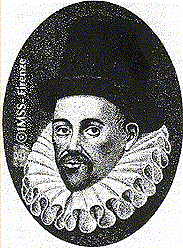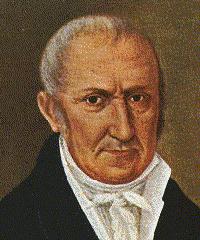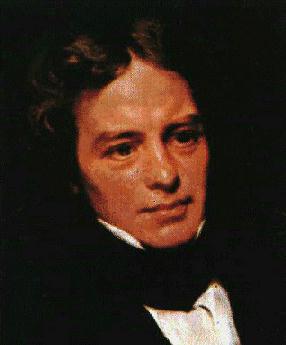![]() The Ancients. The effects of Magnetism and Electrostatics were
known from ancient times;
Thales
of Miletus discussed the lodestone, which he believed contained a
soul, and ancient Greeks knew that amber rods, rubbed with fur, developed
a charge. In the early 1200's, lodestones were being used as compasses
(they always point to the magnetic North). The development of
understanding was speeded up by the establishment of the scientific method
(via Mechanics).
The Ancients. The effects of Magnetism and Electrostatics were
known from ancient times;
Thales
of Miletus discussed the lodestone, which he believed contained a
soul, and ancient Greeks knew that amber rods, rubbed with fur, developed
a charge. In the early 1200's, lodestones were being used as compasses
(they always point to the magnetic North). The development of
understanding was speeded up by the establishment of the scientific method
(via Mechanics).

![]() William
Gilbert (1540-1603). Gilbert has been called "the Galileo of
magnetism". Apparently his duties as personal physician to Queen
Elizabeth I of England allowed him time to study several scientific
questions. He was the first to make a truly systematic study of magnetism,
summarized in his famous treatise, De Magnete, he
concluded that each magnet has two poles, that forces between poles can be
attractive or repulsive, and suggested that the earth is a large magnet.
He studied electricity and its difference from magnetism, developing a
list of substances which he found became charged upon rubbing. He also
demonstrated that the earth spins about its own axis (in opposition to
Brahe's views).
William
Gilbert (1540-1603). Gilbert has been called "the Galileo of
magnetism". Apparently his duties as personal physician to Queen
Elizabeth I of England allowed him time to study several scientific
questions. He was the first to make a truly systematic study of magnetism,
summarized in his famous treatise, De Magnete, he
concluded that each magnet has two poles, that forces between poles can be
attractive or repulsive, and suggested that the earth is a large magnet.
He studied electricity and its difference from magnetism, developing a
list of substances which he found became charged upon rubbing. He also
demonstrated that the earth spins about its own axis (in opposition to
Brahe's views).
![]() Charles
Francois du Fay (1698-1739), superintendent of the gardens of the King
of France, discovered that rubbing two different objects together produced
two types of electric charge. He adhered to the view that matter contained
two types of fluid, normally in exact balance; when two bodies were rubbed
together, however, this balance was disturbed, and each body acquired an
excess of one or the other type of fluid.
Charles
Francois du Fay (1698-1739), superintendent of the gardens of the King
of France, discovered that rubbing two different objects together produced
two types of electric charge. He adhered to the view that matter contained
two types of fluid, normally in exact balance; when two bodies were rubbed
together, however, this balance was disturbed, and each body acquired an
excess of one or the other type of fluid.
![]()
 Benjamin
Franklin. (1706-1790) A Freemason, a printer, an inventor, a
politician, a statesman and a scientist, Benjamin Franklin was one of the
several extraordinary men who emerged in America around the time of its
struggle from independence from England. Although he initially wished to
keep America an English colony his time as ambassador to France during the
American war of independence changed his mind and he was one of the
Founding Fathers of the United States, and a major contributor to the
Declaration of Independence; "we hold these truths to be
self-evident, that all men are created equal" is largely his
work. He was much loved in France as a "son of Nature", and when
he died the Assembly Générale closed for three days. He was
a strong proponent of basic science - "of what use is a new-born
baby?" he is rumoured to have asked of a sceptic - and he was
particularly fascinated by electricity. He did a series of very dangerous
experiments which involved flying a kite into thunder clouds; several of
his imitators were killed. He invented the lightning rod, pointing out
that a pointed end would be more valuable than a rounded one. He was one
of the first to propose the "one fluid" theory of what gets
rubbed off when bodies charge by friction; this theory proposed that only
one of the charges moves. Unfortunately for generations of students, his
chosen direction of flow was chosen to be opposite to that which we now
call electron flow.
Benjamin
Franklin. (1706-1790) A Freemason, a printer, an inventor, a
politician, a statesman and a scientist, Benjamin Franklin was one of the
several extraordinary men who emerged in America around the time of its
struggle from independence from England. Although he initially wished to
keep America an English colony his time as ambassador to France during the
American war of independence changed his mind and he was one of the
Founding Fathers of the United States, and a major contributor to the
Declaration of Independence; "we hold these truths to be
self-evident, that all men are created equal" is largely his
work. He was much loved in France as a "son of Nature", and when
he died the Assembly Générale closed for three days. He was
a strong proponent of basic science - "of what use is a new-born
baby?" he is rumoured to have asked of a sceptic - and he was
particularly fascinated by electricity. He did a series of very dangerous
experiments which involved flying a kite into thunder clouds; several of
his imitators were killed. He invented the lightning rod, pointing out
that a pointed end would be more valuable than a rounded one. He was one
of the first to propose the "one fluid" theory of what gets
rubbed off when bodies charge by friction; this theory proposed that only
one of the charges moves. Unfortunately for generations of students, his
chosen direction of flow was chosen to be opposite to that which we now
call electron flow.
![]()
 Charles August Coulomb(1763-1806). Coulomb was born in Angouleme,
France. As a military engineer, he constructed the Bourbon fort in
Martinique, where he worked for 9 years. His health deteriorated and, at
the beginning of the French revolution, he returned to France to retire.
He invented the torsion balance, which allowed him to study the very small
forces between electrostatically charged objects. He showed that the force
between two charges is proportional to the size of the charge, and
inversely to the square of the distance between them.
Charles August Coulomb(1763-1806). Coulomb was born in Angouleme,
France. As a military engineer, he constructed the Bourbon fort in
Martinique, where he worked for 9 years. His health deteriorated and, at
the beginning of the French revolution, he returned to France to retire.
He invented the torsion balance, which allowed him to study the very small
forces between electrostatically charged objects. He showed that the force
between two charges is proportional to the size of the charge, and
inversely to the square of the distance between them.
![]()
 Alessandro
Volta. (1745-1827) Invented the battery, using layers of zinc and
copper with wet pasteboard between them (more modern ordinary commercial
batteries consist of a shell of zinc - the cathode - which holds a moist
paste of ammonium chloride - the electrolyte - with a carbon rod - the
anode - inserted in the middle. There are now many different combinations,
such as mercury, Nickel-Cadmium, etc.). Moving charges (electric currents)
could now be studied. He also realized that the "galvanic"
effects (so called after Galvani, who, in 1780, noticed that frog's legs
responded by contracting when given an electric impulse) arose from the
fact that nerves conduct electricity.
Alessandro
Volta. (1745-1827) Invented the battery, using layers of zinc and
copper with wet pasteboard between them (more modern ordinary commercial
batteries consist of a shell of zinc - the cathode - which holds a moist
paste of ammonium chloride - the electrolyte - with a carbon rod - the
anode - inserted in the middle. There are now many different combinations,
such as mercury, Nickel-Cadmium, etc.). Moving charges (electric currents)
could now be studied. He also realized that the "galvanic"
effects (so called after Galvani, who, in 1780, noticed that frog's legs
responded by contracting when given an electric impulse) arose from the
fact that nerves conduct electricity.
![]() Hans
Christian Oersted. (1777-1851). In 1820, during one of his advanced
lectures at the University of Copenhagen, this Danish physicist made the
fundamental discovery concerning the connection between magnetism and
electricity. After studying the effect for three months using a battery he
had constructed, he announced his discovery in a paper written in Latin,
following a time-honoured tradition. By connecting his copper-zinc
batteries to a straight section of conducting wire, he demonstrated the
deflection of a magnet aligned parallel to the wire. Thus he showed that
uniformly moving charges produce constant magnetic fields; as a corollary,
we can see that accelerating charges produce changing
magnetic fields. André-Marie Ampère (1775-1836) quickly
repeated Oersted's experiment, and formulated them mathematically. Ampère
also showed that wires carrying electric currents exert forces on each
other, thus demonstrating that magnetic fields exert forces on electric
currents.
Hans
Christian Oersted. (1777-1851). In 1820, during one of his advanced
lectures at the University of Copenhagen, this Danish physicist made the
fundamental discovery concerning the connection between magnetism and
electricity. After studying the effect for three months using a battery he
had constructed, he announced his discovery in a paper written in Latin,
following a time-honoured tradition. By connecting his copper-zinc
batteries to a straight section of conducting wire, he demonstrated the
deflection of a magnet aligned parallel to the wire. Thus he showed that
uniformly moving charges produce constant magnetic fields; as a corollary,
we can see that accelerating charges produce changing
magnetic fields. André-Marie Ampère (1775-1836) quickly
repeated Oersted's experiment, and formulated them mathematically. Ampère
also showed that wires carrying electric currents exert forces on each
other, thus demonstrating that magnetic fields exert forces on electric
currents.
![]()
 Michael
Faraday. The son of a blacksmith, Michael Faraday was almost entirely
self-taught. In 1812 he attended the lectures of Sir Humphry Davy,
director of the Royal Institution. He submitted his notes of these
lectures to Davy with a request for a position, however menial. Davy took
him under his wing at the Institution where he remained for the rest of
his scientific career, eventually ascending to the post of director.
Davy's support enabled him to pursue a most productive series of
experimental investigations, initially in Chemistry, and then, for 40
years, in Physics. To him we owe the concept of field and field lines. His
name is also associated with electromagnetic induction; spurred by
Oersted's realisation that electricity produces magnetism, he successfully
showed the converse, that magnetism produces electricity. After a series
of investigations spanning over six years, he discovered that a moving
magnet induces electric current in a neighbouring wire.
Michael
Faraday. The son of a blacksmith, Michael Faraday was almost entirely
self-taught. In 1812 he attended the lectures of Sir Humphry Davy,
director of the Royal Institution. He submitted his notes of these
lectures to Davy with a request for a position, however menial. Davy took
him under his wing at the Institution where he remained for the rest of
his scientific career, eventually ascending to the post of director.
Davy's support enabled him to pursue a most productive series of
experimental investigations, initially in Chemistry, and then, for 40
years, in Physics. To him we owe the concept of field and field lines. His
name is also associated with electromagnetic induction; spurred by
Oersted's realisation that electricity produces magnetism, he successfully
showed the converse, that magnetism produces electricity. After a series
of investigations spanning over six years, he discovered that a moving
magnet induces electric current in a neighbouring wire.

![]() Maxwell.
(1831-1879). Achieved a synthesis of all the experimentally observed
data on electricity and magnetism in his four equations. By a brilliant
insight he saw the need for an extra term in one of the equations; its
existence led to the prediction of electro-magnetic waves, which were
discovered in 1895 by Hertz, and exploited by Marconi in 1896. In a sense
Maxwell's work was the final capstone in classical physics. Indeed, at the
end of the 19th century one physicist proclaimed the impending death of
physics; since all fundamental physical phenomena were now understood,
physicists could leave the working out of the details and the mopping up
of a few remaining but trivial questions to lesser scientists, such as
chemists and engineers. How wrong he was! It is one of the great ironies
of science that the very experiments performed by Hertz, triumphantly
verifying Maxwell's prediction using the photo-electric effect, turned out
to have no obvious classical explanation. The exploration of this question
was to lead to the first assault on the classical view, and a radical and
extraordinary shift in our understanding of Nature. On to quantum
mechanics!
Maxwell.
(1831-1879). Achieved a synthesis of all the experimentally observed
data on electricity and magnetism in his four equations. By a brilliant
insight he saw the need for an extra term in one of the equations; its
existence led to the prediction of electro-magnetic waves, which were
discovered in 1895 by Hertz, and exploited by Marconi in 1896. In a sense
Maxwell's work was the final capstone in classical physics. Indeed, at the
end of the 19th century one physicist proclaimed the impending death of
physics; since all fundamental physical phenomena were now understood,
physicists could leave the working out of the details and the mopping up
of a few remaining but trivial questions to lesser scientists, such as
chemists and engineers. How wrong he was! It is one of the great ironies
of science that the very experiments performed by Hertz, triumphantly
verifying Maxwell's prediction using the photo-electric effect, turned out
to have no obvious classical explanation. The exploration of this question
was to lead to the first assault on the classical view, and a radical and
extraordinary shift in our understanding of Nature. On to quantum
mechanics!